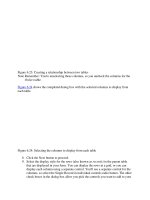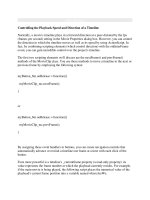Ignoring the obvious combined arms major thomas a bruno, united states marine corps
Bạn đang xem bản rút gọn của tài liệu. Xem và tải ngay bản đầy đủ của tài liệu tại đây (1.13 MB, 116 trang )
ThiseditionispublishedbyPICKLEPARTNERSPUBLISHING—www.picklepartnerspublishing.com
Tojoinourmailinglistfornewtitlesorforissueswithourbooks–
OronFacebook
Textoriginallypublishedin1995underthesametitle.
©PicklePartnersPublishing2015,allrightsreserved.Nopartofthispublicationmaybereproduced,storedina
retrievalsystemortransmittedbyanymeans,electrical,mechanicalorotherwisewithoutthewrittenpermissionofthe
copyrightholder.
Publisher’sNote
AlthoughinmostcaseswehaveretainedtheAuthor’soriginalspellingandgrammartoauthenticallyreproducetheworkoftheAuthorandtheoriginal
intentofsuchmaterial,someadditionalnotesandclarificationshavebeenaddedforthemodernreader’sbenefit.
Wehavealsomadeeveryefforttoincludeallmapsandillustrationsoftheoriginaleditionthelimitationsofformattingdonotallowofincludinglarger
maps,wewilluploadasmanyofthesemapsaspossible.
IGNORINGTHEOBVIOUS:COMBINEDARMSAND
FIRE&MANEUVERTACTICSPRIORTOWORLD
WARI
by
MajorThomasA.Bruno,UnitedStatesMarineCorps
TABLEOFCONTENTS
Contents
TABLEOFCONTENTS
EXECUTIVESUMMARY
Thesis
Discussion
Conclusions
I.INTRODUCTION
II.BACKGROUND:TECHNOLOGY,TACTICS,ANDTHECHANGINGNATUREOFWAR
III.ABAPTISMBYFIREPOWER:
III-A.TheRusso-JapaneseWar(1904-05)—InfantryTactics
III-B.POSITIONINFANTRYANDTHEBASEOFFIRE
III-C.INDIRECT-FIREARTILLERY&COMBINEDARMS
IV.THESIEGEOFPORTARTHUR:
CombinedArmsandSmall-UnitManeuver
V.CONCLUSION
APPENDIXA:THEENDOFANERA
TheAmericanCivilWar(1861-1865)
APPENDIXB:BREAKINGTHELINES
WarsofGermanUnification(1864-1871)
APPENDIXB:PARTII—THERISEOFTHECAPTAIN
PrussianDoctrineofSubordinateInitiative
APPENDIXB:PARTIII—LEADERSHIPBYDIRECTIVE
Weisungsführung
APPENDIXC:VICTORYTHEHARDWAY
TheAnglo-BoerWar(1899-1902)
APPENDIXC:PARTII—INTERPRETATIONSOFTHEBOERWAR
ObservationsofForeignMilitaryObservers
APPENDIXD:TERMSANDDEFINITIONS
Tactics&Techniques
Fires
TacticalFormations
LevelsofWar
WarfightingDoctrines/Philosophies
REQUESTFROMTHEPUBLISHER
BIBLIOGRAPHY
NAPOLEONICSKIRMISHERTACTICS
CIVILWAR
WARSOFGERMANUNIFICATION/PRUSSIANDOCTRINE
ANGLO-BOERWAR
RUSSO-JAPANESEWAR
GENERALSOURCES
DOCTRINALPUBLICATIONS
EXECUTIVESUMMARY
Thesis
Fairly or unfairly, the stalemate on the First World War’s Western Front is often
attributedtotheintellectualstagnationoftheera’smilitaryofficers.Thispapertracesthe
development(orabsenceofdevelopment)ofcombinedarmsandfire&maneuvertactics
anddoctrineintheperiodpriortoWWI,focusingontheRusso-JapaneseWar.
Discussion
The Western armies that entered the Great War seemingly ignored many of the hardlearnedlessonsandobservationsofpre-warconflicts.ThoughWorldWarIarmieswere
later credited with developing revolutionary wartime tactical-level advances, many
scholarsclaimthatthisphaseoftacticalevolutionfollowedanearlierperiodofintellectual
stagnationthatresultedinthestalemateonthewar’sWesternFront.Thisstalemate,they
claim, could have been avoided by heeding the admonitions of pre-war conflicts and
incorporatingtheburgeoningeffectsoftechnologyintomilitarytacticsanddoctrine.Some
goevenfurtherandfaultthemilitaryleadershipwithincompetenceandfoolishnessfornot
adaptingtotherequirementsofmodernwar.
TheRusso-JapaneseWarshowedthenecessityforcombinedarmstechniquesandfire
andmaneuvertacticsonthemodernbattlefield.Specifically,thewarshowedtheneedfor:
(1)theadoptionofdispersed,irregular(non-linear)formations;(2)theemploymentoffire
andmaneuvertechniquesandsmallunit-tactics,includingbaseoffiretechniques;(3)the
transitiontoindirect-fireartillerysupporttoensurethesurvivabilityofthebatteries,and;
(4) the necessity for combined arms tactics to increase the survivability of assaulting
infantryandcompensateforthedispersionofinfantryfirepower.
However,deeplyingrainedconcernsoverthelossofcontrolonthebattlefieldandfaith
intheabilityofmoraletoovercomefirepowerpreventedthefullrealizationofadvanced
combined arms techniques and fire and maneuver tactics. Instead, the lessons of the
Russo-JapaneseWarweredisregardedorminimized.
Conclusions
Military leaders did not ignore the lessons of the Russo-Japanese War. In fact, the
ramifications of increased firepower and rudimentary techniques of fire and maneuver
tactics were addressed in most nations’ pre-World War I doctrine. Unfortunately, these
conceptswerenotfullydevelopedorpracticedduetoafailuretorecognizeachangeto
thefundamentalnatureofwarfareitself.Massivefirepowernecessitatedanewsystemof
warfare. To effect this type of transformation, the entire military culture—equipment,
doctrine, organization, and leadership— would have to evolve. Lamentably, the hardearned lessons of the Boer and Russo-Japanese Wars had not prompted such a
reformation.ItwouldtakethecataclysmoftheFirstWorldWartoactasacatalystforthis
transformation.
Insummary,mostmilitaryofficersrecognizedthelethalityofmodernweaponryprior
to the First World War but consciously decided that offensive spirit and morale could
overwhelmfirepower.
“…bulletsquicklywritenewtactics.”[1]—LieutenantGeneralWilhelmBalck,1922
“Our long garrison life has spoiled us, and effeminacy and desire for and love of pleasure, have weakened our
militaryvirtues.TheentirenationmustpassthroughtheSchoolofMisfortune,andweshalleitherdieinthecrises,ora
better condition will be created, after we have suffered bitter misery, and after our bones have decayed.”[2]—Field
MarshalvonGneisenau,1806
“Iamnotatallinterestedinthatsillynonsenseyouhaveshownme.Crawlingaround,takingcover,camouflageand
indirect-fire:Idon’tunderstandthesethingsanddon’tcareadime.I’dliketoseeadashingregiment,galopping[sic]
ontothebattlefield,takinguppositionsandfiringquickly!”[3]—FieldMarshalCarlTersztyanskydeNados,1911
I.INTRODUCTION
“ThehorrorsoftheFirstWorldWar—themachineguns,trenchtactics,barbedwireandpoundingartillery—came
asaghastlysurprisetothegenerals.Yettheyshould,andcould,haveknownbetter.In1904JapanandRussiahadgone
towarfordominanceoftheEast.Journalistsandmilitaryattacheshadmademeticulousobservations,butthelessonsof
thisdramaticconflictweredismissedasirrelevant.”[4]
NearlyeveryhistoricalstudyoftheFirstWorldWarcontainsacommentaryalludingto
the effects of increased firepower and technology on the nature of warfare. In 1922,
GermanGeneralWilhelmBalckwrote,“Bulletsquicklywritenewtactics.”[5]However,
mosthistoricalanalysesofWorldWarIwouldhavethereaderbelievethatthepre-warera
did not bear out his adage. The Western armies that entered the Great War seemingly
ignoredmanyofthehard-learnedlessonsandobservationsofpre-warconflicts.Though
World War I armies were later credited with developing revolutionary wartime tacticalleveladvances,[6] many scholars claim that this phase of tactical evolution followed an
earlierperiodofintellectualstagnationthatresultedinthestalemateonthewar’sWestern
Front.Thisstalemate,theyclaim,couldhavebeenavoidedbyheedingtheadmonitionsof
pre-war conflicts and incorporating the burgeoning effects of technology into military
tactics and doctrine. Some go even further and fault the military leadership with
incompetenceandfoolishnessfornotadaptingtotherequirementsofmodernwar.
As early as the American Civil War (1861-1865) several indicators warned that the
natureofwarfarewaschangingduetothedevelopmentsofnewtechnology.TheWarsof
German Unification (1864-71)[7], especially the Franco-Prussian War (1870-71),
confirmedthatthefaceofwarfarehadtransformedsufficientlytorequirenewtacticsand
doctrine.Thoughsomereformswereimplemented,thefundamentalsofNapoleonicbattle
werestillcommonlypracticed.[8]Later,lessonsderivedfromtheAnglo-BoerWar(18991902) and Russo-Japanese War (1904-5), caused several military organizations to enact
further reforms. These later conflicts demonstrated the devastating effect of increased
firepower.Bothwarswitnessedtheevolutionofdecentralizedsmall-unitinfantrytactics,
rudimentary fire and maneuver methods, and basic combined arms techniques—with
small groups of soldiers led by junior officers and NCOs, advancing in irregular
formations under the cover of closely coordinated artillery cover— to overcome the
lethalityofthemodernbattlefield.
The most basic change required was the evolution of infantry doctrine beyond the
traditional usage of skirmish line tactics. Dispersion, decentralization, and small-unit
maneuverwerenecessaryforattackinginfantrytoadvancethroughtheenemydefensive
zone.Yet,attheoutsetoftheWorldWar,itwasnotuncommonforboththeAlliedand
CentralPowerarmiestoemploydense,close-orderattackcolumns.[9][10]
EvenpriortotheFirstWorldWar,theRusso-JapaneseWardemonstratedtheneedfora
firepower‘solution’totheproblemofcoveringtheinfantryasitadvancedacrossthefireswept defensive zone. Now more than ever before, organic and supporting fires were
critical to suppressing enemy defensive firepower during the infantry advance.
Specifically, the Boer and Manchurian conflicts witnessed the development of basic fire
andmaneuvertechniquesbyemployingpositioninfantry—actingasanembryonicbase
offire—to support the maneuver of infantry attacks. In the years prior to World War I,
severalnationsdirectedtheemploymentofpositioninfantryintheirtacticaldoctrines.In
later years, the German army would expand small-unit decentralization and base of fire
conceptsintoanadvancedfireandmaneuvertacticalsystem.
Artillery support was also needed to provide accurate fires to cover the maneuver of
dispersed attacking units. This coordination was made more difficult by the war’s
transitionfromdirecttoindirect-fireartillerysupport.Thedispersionofartillerybatteries
and increased distance from the frontlines, combined with the era’s primitive
communications technology, made the facilitation of combined arms and massed fires
moredifficult.Althoughmostnationsattemptedtoamelioratethesituationbyestablishing
asystemofforwardobserverswithspecialcommunicationsandsignalingtechniques,the
majority of combined arms coordination issues would remain unsolved until after the
outbreakofWorldWarI.
Theoverallsolutiontocrossingthefire-sweptzonewoulddemandmorethanmerely
modifyingofinfantrytacticsandartilleryfiringtechniquesalludedtoabove.Specifically,
it would require precise coordination between the artillery and infantry arms—namely,
combined arms. Artillery fires were critical in suppressing enemy defensive fires during
theinfantryadvance.Additionally,supportingfireswerenecessarytocompensateforthe
dilutionoffirepowerresultingfromthedispersionofinfantryformations.
Several observers noted the aforementioned implications of modern war. Several of
these observations were codified into written military doctrine. Unfortunately, it would
takethecatastrophiclossesoftheFirstWorldWar’searlycampaignstoactasacatalyst
forsubstantivechangeinmilitarydoctrineandtactics.Apparently,observationsinvolving
theapplicationofadvancedwarfightingtechniquestoovercometheeffectsoffirepower
werenotfullyheededpriortotheoutbreakoftheGreatWar.Thelessonsofthisoversight
remain applicable to modern military institutions—the ability to recognize the
implications of technology on warfare and the need for tactical and doctrinal
transformationremainscriticaltopresent-daymilitaryofficers.Accordingly,studyingthe
reactionofpre-WorldWarIarmiestothedevelopmentsoftheRusso-JapaneseandBoer
Warsremainscogenttocontemporarymilitaryorganizations.
II.BACKGROUND:TECHNOLOGY,TACTICS,ANDTHECHANGING
NATUREOFWAR
The nineteenth century witnessed several phases of technological advancement. The
first phase of technological progress occurred in the mid-nineteenth century and saw
drastic improvements in the effectiveness of weaponry, transportation, and
communications. Scholars cite the advent of rifled weapons, breech-loading armament,
railroads, and the telegraph as examples of new technology available on the battlefield.
[11]Accordingly,manyhistoriansdescribetheAmericanCivilWarasthefirstmajorwar
in the Industrial Age.[12] These innovations had profound effects on the Napoleonic
tacticsstillbeingpracticedbymostmilitaryorganizations.Increasedfirepowerresultedin
the expansion of skirmisher tactics and an emphasis on flanking maneuvers. However,
mostarmiesstubbornlyclungtoclose-ordertacticsastheprimarybattleformationinthe
post-waryears.[13]
A second phase of technology surfaced in the late nineteenth century. This period
brought about military advances that perfected the earlier innovations of the century.
Inventionssuchasmagazine-fedrepeatingrifles,quick-firingartillery,machineguns,and
smokeless powder, combined to further increase the lethality of firepower.[14] Some
military observers believed that the ramifications of the magazine-rifle’s flat trajectory,
smokeless powder, and quick-firing artillery had a greater impact than the previous
emergence of the breechloader. Specifically, the use of smokeless powder and the
magazine-rifle extended the zone of lethal fire from 500 yards (of the previous
breechloaders)to900yardsinfrontofthedefensiveline.Combinedwiththehigherrates
offire,itmadethisarea“practicallyimpassible.”Direct,frontalattacksagainstentrenched
troopswerenowconsidered“suicidal”bysomeofficers.[15]
The combined effects of these military advances made offensive attacks risky and
furtherstrengthenedtheadvantagesofadefensivemilitaryposture.Therequirementfor
proficient staff planning became absolutely essential due to the devastating effects of
defensive firepower. Staffs were necessary to ensure coordination between the different
service arms within the army. Although most military organizations were slow to
recognize the importance of combined arms—the complete coordination of all service
armsandsupportorganizations—theconceptwastobecomeessentialtomodernwarfare.
[16]
By studying the American Civil War and the Wars of German Unification, some
officers had identified the tactical implications of the first phase of the Industrial Age.
These conflicts highlighted the lethal effects of the rifled-musket and breechloader and
signaled the end for antiquated close-order tactics. Later, the Anglo-Boer War and the
Russo-Japanese War demonstrated the necessity of combined arms due to the
enhancementsofthesecondphaseoftechnology.ThetacticallessonsoftheSouthAfrican
andRusso-JapaneseWarsshouldhaveestablishedtherequirementforcombinedarmsto
supportmoderninfantryattacks.[17]
III.ABAPTISMBYFIREPOWER:
III-A.TheRusso-JapaneseWar(1904-05)—InfantryTactics
TheRusso-JapaneseWarhasoftenbeendescribedasapreludetothetrenchwarfareof
theFirstWorldWar.ThebattlefieldsoftheManchuriancampaignwerestrikinglysimilar
to those of the First World War’s Western Front. For the first time in the modern era,
opposing trench lines were constructed—fortified with barbed wire, machineguns,
minefields,andmassiveartilleryformations.Forinstance,theBattlesontheSha-hosaw
trenchlinesthatstretchedfor200miles,separatedinsomeareasbymereyards.[18]World
WarIstormtrooperswouldlateroperateinsimilarsurroundings.
Both Russia and Japan entered the war with traditional military doctrine and tactics.
The Russian army’s doctrine was based on the venerable principles of Dragomirow—
employing dense skirmish lines to maintain a high volume of fire. The Russian army
utilizeddenseformationstoachievefirepowersuperiorityandtheshockeffectofthefinal
bayonetcharge.BothnationshadyettofullyincorporatethelessonsoftheBoerWar—
namely,theimportanceofmassedfirescombinedwiththedispersionofmanpower.Inthe
caseofRussia,eventhebasiclessonsoftheFranco-PrussianWarhadyettobeinstituted.
[19] The Japanese, mentored by German army officers, possessed a more flexible
commandsystemthantheirRussianadversaries.TheJapanesearmyadoptedtheGerman
principleofAuftragstaktik,[20] which contributed to their ability to rapidly adapt to the
effects of the modern battlefield.[21] Successful Japanese infantry tactics developed
duringtheRusso-JapaneseWarunderscoredthefactthatmoderncombatnowdepended
upon an army’s ability to “clearly [act] according to circumstances, without regulation
formations,andwithoutofficialbasis.”[22]
The harsh reality of modern firepower would force progressive thinking military
officers to devise the tactical innovations mentioned previously—irregular, dispersed
infantry tactics, rudimentary base of fire tactics, combined arms tactics, and the
coordinationofindirect-fireartillerysupportwithinfantrymaneuver.Inordertopenetrate
the fire-swept battle zone, both nations would be forced to modify their tactics (albeit
moreslowlyfortheRussians)tocompensateforenemyfirepower.Thoughbothnations
modifiedtheirtacticsduringthewar,theJapanesearmy’sflexiblecommandandcontrol
doctrinemustbecreditedwithallowingthemtoadapttomodernwarmorerapidlythan
the Russians. By war’s end, the Japanese had adopted revolutionary tactics employing
small groups of soldiers in irregular formations—crawling, running, and rushing across
the battlefield—to take fortified enemy positions. Though less frequently observed,
rudimentary infantry base of fire techniques were also devised to support infantry
maneuver. Beyond adopting irregular, dispersed formations, Japanese assaults were now
closely coordinated with artillery covering fire, precisely timed to support the infantry
maneuverelement.
The most basic tactical evolution necessary to counter the increased firepower of the
modernbattlefieldwasthedispersionofinfantryformations.Unfortunately,Russianprewar doctrine was founded in shock tactics and bayonet charges rather than the
concentrationoffirepower.Toachieveadensityoffirepowerandshockeffect,formations
with narrow frontages were commonly employed. Units arrayed in close-order were
(theoretically)expectedtooverwhelmtheenemy.[23][24]Earlyintheconflict,German
observers noted the Russian reliance on close-order shock action, rather than fire
superiority,tobedecisiveinbattle:
“Insteadofinsistinguponathoroughindividualtrainingofthemenforfireaction,stricteducationinfirediscipline,
andproperwarlikepracticeindirectingfireactionandinhandlingtroops,theRussianregulationsexpectedsuccessfrom
obsoleteshocktacticswithoutsufficientuseofskirmishersandwithoutenoughpreparationbyfire.”[25]
In actuality, Russian written doctrine espoused the employment of extended-order
skirmisher formations, but their application was generally ignored due to perceived
difficultiesincommand.[26]
The effects of technology had greatly extended the ranges of most weapons.
Consequently,itwascommonplaceforartillerytoengagetargetsasfaras6,000to7,000
yards. This occurrence had several implications for attacking infantry. Now, even rear
areasweresusceptibletoenemylong-rangeartilleryfire,especiallyinobservableterrain.
Tactical necessity forced Russian troops to deploy early into chain (skirmisher)
formations,especiallywheninopenterrainwithinrangeofenemyartillery.(Itbecamea
generalruletodeploycompaniesintoskirmishlinesatrangesasfaras3,500yards,butno
fartherthan2,300yardsfromtheenemy).DuetotheaccuracyofJapaneseartillery,closeorder movement in observed terrain became “absolutely impossible.” Heavy rifle fire
restricted the maneuver of dense infantry formations. Whereas Russian infantry
regulationsstatedthattherangeofeffectiveriflefirebeganat1,000to1,400yardsfrom
the enemy, the lethal effects of Japanese rifle fire extended to ranges over 2,300 yards.
Inside of 1,100 yards, rifle fire became withering. (One source estimated that Japanese
rifle fire caused eighty-five percent of Russian combat losses during the Manchurian
campaign).[27]
Eventually,highratesofaccurateriflefireforcedtheRussianstomodifytheirinfantry
tactics.Often,entirebattalions,notonlycompanies,deployedintoskirmisherformations.
However,Russiantacticsremainedreliantondenseintervalstomaintainhighratesoffire
intheattack.Russianofficerspreferredtoputallavailablemenintothefiringline.Atthe
small-unitlevel,theRussiansbelievedthatinfantryreserveswereofminimalimportance
since they often incurred casualties during the advance without contributing to the
firepoweroftheunit.Thus,allavailablemenweredeemednecessarytobolsterthefiring
line. As a result, company reserves were not regularly maintained, leaving regimental
reservesasthelowestleveloftacticalreinforcement.[28]
Ideally, Russian skirmish lines advanced at a run, taking maximum advantage of
terrain.Russianregulationsstatedthatthefiringlineshouldrapidlyadvancetofinalfiring
positions (located approximately 300-500 paces from the enemy lines) to form for a
bayonet attack. Though Russian officers still believed firmly that the bayonet charge
remained the final decisive action of infantry combat, they also realized that to be
successful final firing positions needed to be much closer to the enemy lines than
stipulated in the regulations. As a result, the final firing position prior to the bayonet
charge was usually located in a covered area in close proximity to the enemy lines.
Sometimesthisdistancewasamerefifteentotwentypacesfromtheenemyposition.At
longer distances, the bayonet charge usually resulted in failure and excessive casualties.
[29] Thus, infantry necessarily relied upon a combination of fire and movement and
firepower(organicandsupporting)tosupporttheadvancetotheirfinalattackpositions.
But,becausethefinalbayonetchargewouldbevirtuallyunsupportedbyfires,itsdistance
hadtobenecessarilyshortened.
Nevertheless, most Russian officers doubted claims that positions could be taken by
fire alone, and still believed that the bayonet attack remained the decisive method to
overtakeanenemyposition.[30] The experiences in Manchuria confirmed the Russian’s
faith in bayonet charges to overwhelm the enemy and solidify the morale of friendly
soldiers.[31](PriortotheRusso-Japanesewar,somemilitarythinkerscorrectlytheorized
that the increased accuracy, range, and rate of fire had made the bayonet charge
unnecessary.However,duringtheRusso-JapaneseWar,mostmilitaryobserversnotedthat
bayonet charges, in both day and night attacks, were often employed to carry the final
decisivebattleaction).[32]
Notwithstanding, the Russians seemed to adapt more slowly to the ramifications of
modernwar.DuringtheRussianattackonMo-tienLing(17July1904)thetroopsofthe
10thand24thEastSiberianRegimentswereformedinclose-orderformationstoadvanceon
the Japanese defensive positions. The Japanese capitalized on the vulnerable target and
haltedtheadvance.[33]AslateastheattackonWu-chang-yingandChaing-liang-pu(14
October 1904), two regiments of the Russian 6th Siberian Corps attacked in antiquated
close-orderformations.Amazingly,thebattalionswereformedupandinspectedinparade
fashion, in full view of the waiting Japanese garrison. The formation marched at quicktime without any extension of the ranks. Outside of seven hundred yards from the
JapanesepositiontheRussiansformedintoasinglebattlelineandcontinuedtheadvance,
asifonparade.TheJapanesedefenderseasilyrepulsedtheexposedinfantrymen,takinga
heavytollofRussiancasualties.Afterthefailureofthefirstattempt,twobattalionsofthe
Russianbrigadereservesattackedinthesamefashion.Thefollow-onattackmetthesame
fateasthefirst,(withoneregimentalonelosingnearly2,000men).[34]Amazingly,oneof
the same regiments had attacked a strong Japanese position using the same outdated
tactics only two days earlier (on 12 October). The 219th Yukhnov Regiment attacked a
position occupied by six Japanese infantry battalions and supported by eleven artillery
batteries.At600yards,theJapaneseopenedfirewithseveralthousandriflesandsixty-six
guns,decimatingtheRussianregiment.TheYukhnovRegimentlosttwenty-twoofficers
and832men,aquarterofitsstrength,inmereminutes.Asaresultofitshorrendouslosses
inthetwoaforementionedbattles,theregimentwasrenderedcombatineffective.[35]
The Russians did, on occasion, successfully employ irregular infantry tactics, though
less frequently than the Japanese. On their attack on One Tree Hill (16 October 1904),
Russian batteries disregarded the Japanese artillery and focused on enemy infantry
positions.RussianinfantryadvancedtothebaseoftheJapanese-heldhillingroupsoffour
tofivemen.Theinfantryregroupedinthedeadareaatthefootofthehillandconducteda
successfulattack.Thoughtheiradvancewaslaterchecked,thetacticalexecutionoftheir
assault was successful. Additionally, the Russian tactics demonstrated both the
effectivenessofconcentratingartilleryfireonenemyinfantry(ratherthanartillery)during
anattack,andtheusefulnessofsmall-unitmaneuverunderfire.[36]
Heavy losses at the outset of the war also caused the Japanese to alter their infantry
tactics.Earlyon,theyabandonedEuropean-styledrillbookmaneuversinfavorofstealthy
advancesandinfantryrushes.[37]TheJapanesequicklyrealizedthatfiresuperiority,not
shockpower,wasthekeytomoderninfantryattacks.[38]Japaneseinfantrywereinitially
formed in dense skirmish lines (with an interval of one pace) to achieve a heavy
concentrationoffire.Demonstratingbasicfireandmovementtactics,theinfantryadvance
was conducted by a series of rushes. Platoon-sized units (zugs), from the flanks of the
skirmishline,normallyexecutedtheinitialrushes.Theremainingtwoplatoonsprovided
coveringfireduringthemovement.Thealternatingrushesweredesignedtoadvancethe
lineforwardinsections,withtwo-thirdsoftheunitengagingincoveringfireduringthe
advance.[39]
Thelengthofeachrushdependedontheterrainandtacticalsituation,especiallyenemy
fire.Ateachsuccessiveposition,theJapanesesoldiersconstructedhastyentrenchmentsin
thepronepositiontoshieldthemfromenemyfire.Inordertoreducecasualtiesatcloser
ranges, individual soldiers, located near the enemy flanks, normally executed the final
advance.Iftheenemy’sfrontwasnarrow,thedoctrinalreactionwastomaneuvertoflank
thepositionwhileapinningforceattackedfrontally.Whenattackingbroadfrontages,the
Japaneseattemptedtopiercetheenemyline.[40]
Ifthefiringlineencounteredseverefire,theywouldoftenhalttheadvance,entrench,
andawaitreinforcement.Supportsfollowedtheadvancingskirmishlinesatrangesof100
to 150 meters behind the skirmish line. When the advance recommenced, the remaining
supports would trace the firing line, making use of the hasty field works previously
constructed by the skirmishers. If necessary, the skirmish line would conduct additional
seriesofhastytrenchlinesduringtheiradvanceinordertomaintaintheirpositions.Asthe
skirmish line conducted its successive rushes, supports would occupy their abandoned
trenchlines.Likewise,reservesoccupiedthepositionslastvacatedbythesupports.The
advancecontinuedinthismanneruntiltheenemypositionwasoverrun.[41]
OneRussiandefensivetacticwastoallowtheJapanesetoapproachwithin100to200
pacesandthendischargealethal,concentratedvolley-fire.[42]Often,thiswaswhenthe
Japanese advance stalled and needed reinforcement. Correspondingly, the Japanese
devisedadefensivetacticoffallingbackfromtheirpreparedpositionstorepulseRussian
attacks. During the Russians’ final charge, Japanese soldiers would then fire on the
advancingenemysoldierswhiletheynegotiatedtheirabandonedtrenchline.[43]
To compensate for the high losses sustained by attacks, the inducement to conduct
nightattacksincreased.[44]TheJapanesemadeextensiveuseofnightattacks,especially
to compensate for the vulnerability of attacking over open terrain. The attack normally
commencedwithanartillerybombardment,followedbyapre-dawnassault.Severalfeints
preceded the main attack to deceive the enemy of the main objective and cause him to
commithisreserves.[45]
Inthefirstmajorlandactionofthewar,theBattleoftheYalu(1May1904),itbecame
obvious that traditional, linear infantry tactics were obsolete. Initially, the Japanese
advancedinextended-order(witha1-2paceintervalinaccordancewiththeirregulations
—laterinthewar,theywouldextendtheintervaltoasmuchasfiveyards,dependingon
the battlefield situation). However, Russian infantry replied with rifle volley-fire as the
skirmish line approached 1,500 to 1,200 paces, causing the Japanese advance to lose its
organization.Althoughhighlydisorganized,theJapaneseinfantrypressedtheadvanceand
succeededinforcingtheRussiansfromtheirtrenchlines.TheJapaneseoverallattackwas
extremelysuccessfulandresultedinaRussianretreat.[46][47]AlthoughtheBattleofthe
YaluwasaJapanesesuccess,theirhighlossesdemonstratedthatrigid,lineartacticswould
nolongerbepracticable.
TheJapanesequicklymodifiedtheirtacticsinreactiontoheavylossesbyemploying
extended-order and irregular formations. For example, during the Japanese advance on
Chiao-tou (July 1904, prior to the above engagement), the soldiers of the 23rd Brigade
moved forward in extended-order formation, with small sections of ten men or less
rushingforward.[48]BythetimeoftheirinitialengagementsnearLiaoyang(30August
1904), the Japanese infantry were observed crawling behind high-growing crops (kaoliang)toconcealtheirmovements.DuringanattackonHill1030,unitsadvancedusing
company rushes of 100-yard intervals.[49] As the Manchurian campaign matured, the
devastating effects of firepower became even more apparent. Dispersion and irregular
formations became a common characteristic of Japanese assault tactics. For example, in
the attacks to recapture Yen-tao-niu-lu (12 October 1904) the Japanese could not
maneuveracrossthebullet-sweptfields,evenusingsectionrushes.Theinfantryreverted
tocrossingthedangerareaingroupsoftwo’sandthree’s.[50]
General Sir Ian Hamilton, a British observer, later described the innovative tactics
utilizedbytheJapaneseonanassaultatTempleHill(11October1904,duringthebattles
ontheSha-ho).HiscommentarywasanaccuratedescriptionoftheJapaneseproclivityto
disregardtraditionalformationsinfavorofaggressivefireandmovementtactics:
“Atthefirstglanceitseemedasiftherewasnoorderorarrangementinthischargeofabrigadeover500or600
yardsofopenplough.ButsuddenlyIrealised[Britishspelling]thatitwasnotchancebutskillwhichhaddistributedthe
pawnssoevenlyoverthechessboard[sic].Thecrowd,apparentlysoirregularandlooselyknittogether,consistedof
greatnumbersofsectionsandhalf-sectionsandgroupsworkingindependently,butholdingwelltogether,eachinone
littlelineunderitsownofficerornon-commissionedofficer.Therewasnoregularinterval…inasmuchastheformation
wasnotsolidbutexceedinglyflexibleandloose,offeringnoveryvaluabletargeteventoamachinegun.”[51]
General Hamilton’s observations noted the rapidly executed attacks of Japanese
General Okasaki’s 15th Brigade. Okasaki’s infantry assault (described above) charged
through a 600-yard open field directly in front of Russian positions. Three successive
skirmish lines were formed with approximately a three pace interval between men. The
lines charged aggressively without regard for maintaining alignment or formation. The
amazing speed of the advance was credited with quickly overwhelming the Russian
defendersanddemonstratedthewillingnessoftheJapanesetoemploydispersed,irregular
formations.[52]
GeneralOkasakiexecutedthesametypeofattackthenextday.Duringanattackonthe
heights of Orr-wa the next morning (12 October 1904), he once again ordered a rapid
charge across another 600-yard field in front of the Russian positions. Once again, the
Japanese infantry overwhelmed the Russian defenders. On both occasions, observers
noted that the attackers halted infrequently during their charges.[53] [54] The German
OfficialHistoryofferedatestamenttoOkasaki’stacticsatTempleHillstating,“Nowhere
onthefieldofattackwerecolumnformationsseenwhichwouldhaveofferedfavourable
targetstotheRussianartilleryontheflanks.”[55][Britishtranslator’sspelling]
The aforementioned tactics show a shift to small-unit, irregular formations (and the
utilization of combined arms to enable their advance). However, when in open terrain
facinglightlyfortifiedpositions,theJapaneserevertedtodoctrinalskirmisher-linetactics.
At Chaohuatun, (in a battle that precipitated the Russian retreat from Mukden), the
Japaneseformedintoskirmishlineswithanintervalofonlyonepace.Japaneseartillery
supportedthebattlebycommencingcounter-batteryfirepriortotheinfantryattack.The
artilleryalsotargetedtheRussianlines.From13:45to18:55theJapaneseinfantryslowly
advancedunderthecoverofartilleryfirefromitsinitialpositionslocatedonly600yards
from the Russian lines. The skirmish line advanced, by a series of 50 to 100 yard-long
rushes,constructinghastytrenchesateachsuccessiveposition.Itwasnotedbyobservers
thatmostoftheJapanesecasualtieswerereceivedduringthelonghaltsatthehastytrench
lines(byenemyrifleandartilleryfire).Onlysmallnumbersofmenfellduringtheactual
rushes.Duringtheinfantryadvance,theJapaneseartillerymaintainedahighrateoffire,
focusing on the Russian lines. The batteries also echeloned forward to maximize its
support.Asthefriendlyinfantryapproached150yardsoftheenemylines,theJapanese
batteriesshiftedtheirfiretotheRussianrearareas.[56]
Onceagain,theclosecoordinationresultingfromcombinedarmseffectscontributedto
the Japanese success. Concentration of fires at the correct time and place supported the
infantryassault.Arguably,thecombinedarmsinteractionfacilitatedtheJapanesesuccess
even though the infantry employed conventional, linear skirmisher tactics. U.S. military
observersreportedthat:
“…thewarwasconductedbybothsidesalongstrictlyorthodoxlines.Theformationoftheinfantryfortheattack,
the massing of the guns, and the concentration of their fire, the value of field fortifications, the siege of permanently
fortifiedlocalities,andsomanyotherfeatures,allsavorstronglyofthetext-book…therecognizedrulesandprinciples
forconductingwarfareunderwentnoseriousmodificationsintheirapplication.”[57]
ThoughtheobservernotedtheproficiencyoftheJapaneseatmodernwar,hemissed
one crucial observation. The Japanese had not merely mastered the already existing
doctrineofmodernwarfare.Japaneseinfantryassaults,attimes,displayedtherudiments
of combined arms attacks that would become a pillar of future tactical doctrines.
Additionally,althoughtheJapaneseonlyrarelyexhibitedtruefireandmaneuverinfantry
tactics, they saw the necessity under specific circumstances, to disregard doctrinal
skirmisherformationsandemployirregularformationsconsistingofsmallgroupsofmen.
Apparently,theJapaneseinfantry’sreturntotheskirmishlineformationsontheopen
terrain surrounding Mukden skewed military observations. Unfortunately, the U.S.
observer’s report missed the points that were to become the main lessons of the
Manchurianconflict,stating:
“ThegreatdispersionwhichwasthreatenedbythelessonsoftheBoerwarfoundnoapplicationinJapanesetactics.
Theintervalsinthefiringlinewerekeptatapaceorpaceandahalf,arathercloseformationtheoretically,formodern
weapons,butgivingavolumeoffiresufficienttocopewiththatofthedefense.TheJapaneseshowedthatthefrontal
attacksbyinfantryoveropengroundarestillfeasiblewhenmadebygoodtroops,wellhandled,andsupportedbyan
adequateartilleryfire.”[58]
However, this commentary is not entirely accurate. While the observation correctly
assesses some of the requirements to conduct a successful attack, it does not credit the
Japanese tactics for the adaptations they displayed in many of the aforementioned
examples.Inseveralcases,theJapanesewereforcedtoabandoncontemporarytacticsin
searchofincreaseddispersion.Intheseinstances,theJapanesetacticsseemedremarkably
similar to the tactics eventually devised by the British during the Boer War. Even more
importantly,thesesameprinciplesofcombinedarmsand fireandmaneuverwouldlater
serveasthefoundationofGermansmall-unitstormtrooptacticsofWorldWarI.
The success of improvised infantry tactics did have an impact on post-war doctrine.
However,pre-FirstWorldWardoctrineremainedtrappedinatransitionalstagebetween
full acceptance of dispersed fire-tactics—dependent on firepower, combined arms, and
small-unit maneuver—and the desire to maintain the control of traditional linear-based
tactics. In an effort to maintain a superiority of fire, American regulations showed a
markedincreaseintheattentiongiventothecoordinationofsupportingarmsandbaseof
fire techniques. However, dense skirmish lines were wrongly preserved in an effort to
achieveaconcentrationofriflefire.
For example, the fledgling fire and maneuver tactics listed in the American Field
Service Regulations, 1913 (FSR, 1913) contained incompatible guidance. The FSR
directed that gaining a superiority of fire required “the placing of as many rifles as
possible on the firing line …” Accordingly, the regulations directed that thin skirmisher
linesbeformedinsectionsassignedsupportingattacks.However,themaineffortwasto
becarriedoutbyheavyskirmishlinesinordertoachieveaconcentrationoffirepowerat
thedecisivearea.DisregardingthelessonsoftheBoerandRusso-JapaneseWars,theFSR
directed that the decisive points of the skirmish line be made “as dense as possible”.
However, the regulations gave the commander the flexibility to advance in “any
formation” he deemed appropriate to the situation to minimize casualties while still
accomplishingthemission—toincludeadvancingbyrushes.Incontrast,othersectionsof
theFSRstubbornlyclungtoadmonitionsabout“maintainingtheintegrityoftheattacking
lineandthevigorofthetroops”,consistentwithtraditionalskirmish-linetactics.[59]
Othernationswerealsoexperiencingatransitionperiod.InbothBritainandFrance,a
doctrinalstruggleensuedbetweenfire-tacticsandthespiritoftheoffensive.Oneschool
believedthatbelievedthatmoraleanddiscipline,imbuedinanoffensiveclanwasa“sure
antidotetofire-power.”[60][Britishspelling]EvenGeneralHamilton,highlyexperienced
inmoderncombat,stated:
“Warisessentiallythetriumph,notofachassepotoveraneedlegun,notofalineofmenentrenchedbehindwire
entanglements and fire-swept zones over men exposing themselves in the open, but of one will over another weaker
will.”[61]
In lieu of developing a firepower solution to cover the final assault, following the
Russo-Japanese War most military organizations acknowledged the expanded necessity
for such military expedients as feints and night attacks. Like Japanese tactics, these
methodssoughttocircumventthedeadlinessofdirect,daylightassaultsbyemployingthe
coverofnightmovements.[62]TheFSR,1913incorporatedseveraloftheselessons.The
regulations contained the addition of an entire section devoted to the details of night
attacks.TheFSRlistedfivecaseswhenanightattackshouldbeconsidered.Recognizing
thelethalityofmodernfirepower,twoofthefivecaseslistedwere:“togaingroundovera
fire-swept zone” and “to make an assault with minimum loss.” Another lesson of the
Manchurian campaign was incorporated in the FSRs’ recommendation to deceive the
enemy as to the location of the main objective by conducting false attacks and
demonstrations along the front.[63] Obviously, military theorists were prescribing
methodsofavoidingdirect,daylightassaultsratherthandevisingthetacticsnecessaryto
supportthemwithfire.
Onlysmallnumbersofofficerspressedforreformsbasedonfirepower.Forexample,
as early as 1912 British Brigadier-General Ivor Maxse believed that modern firepower
demanded the dispersion of unit frontages. Dispersed formations would necessarily
requiresmallsectionstoserveasthenewbaseunit,ledbyNCOs.Rapidfiringweapons
gavesmall-unitssufficientfirepowertosurvive.[64]TheCommandantoftheFrenchWar
School,GeneralJeanColin,(thoughstilladvocatingtheretentionofskirmishlines),also
realizedthatfuturecombatwouldbeconductedbysquadsofsoldiersledbyjuniorofficers
and NCOs. As early as 1912, he foresaw that, “The fighting front [would] no longer
consist of a continuous line of men firing, but rather a certain number of groups or
swarms,eachledbyanon-commissionedofficer.”Thoughtheuseofsuchlightinfantry
‘swarm’ (or ‘horde’) tactics pre-dated Napoleonic times, General Colin’s observations
demonstratehisawarenessoftheneedfordispersiononthemodernbattlefield.[65]
Unfortunately, most senior officers were still concerned with strengthening the firing
linetoachievehighvolumesoffirethroughtroopdensity.[66]Thus,armiesattemptedto
amelioratethedeficienciesoftheBoerandRusso-JapaneseWarsusingoffensivetactics,
morale,anddiscipline—ratherthanarevisedsystemofdoctrineandtacticsbasedonthe
principleof‘maneuver’elementssupportedbyaseparate‘firepower’element.
III-B.POSITIONINFANTRYANDTHEBASEOFFIRE
Dispersedinfantrytacticscouldnotinthemselvesovercomealltheproblemscausedby
modern technology on the battlefield. In fact, extended formations had several inherent
disadvantages.EvenconventionalskirmisherformationsusedduringtheRusso-Japanese
Warhadrevealedseverallimitationsofthetraditionalcommandandcontrolsystems.The
dispersionofextended-orderformations,combinedwithbattlefielddisorder,madecontrol
ofmaneuverandfiredisciplineextremelydifficult.Officersnotedthatsmall-unitcontrol
became increasingly difficult due to individual and section rushes associated with
skirmishertactics.[67]However,itwasnotedthatashoweringofbulletsingeneralareas
madeupforaccuracythatwaslostatlongerrangesandduringinfantryrushes.Thus,it
soon became obvious that the mass of fire in modern battle was more critical than the
accuracyoffire.[68]Thisrealizationledtoanextremelyimportanttacticalevolution—the
development of rudimentary base of fire techniques. Massedfire was now necessary to
suppress defenders during the infantry advance. Position infantry located to the rear or
flanks of the advance, could provide concentrated covering fire to support the infantry
advance.
Arguably, the employment of this rudimentary base of fire technique was the most
advanced infantry tactic devised during the war. The utilization of a base of fire went
beyond the passive technique of dispersing assault formations and actually projected
firepower on the enemy. The base of fire employed organic firepower to cover the
movementofadvancingtroopsastheyadvancedclosetotheenemylines(atthecritical
moment when the support artillery and mortar fires were usually shifted or ceased).
DuringtheFirstWorldWar,theGermanarmywouldlateremploythebaseoffireconcept
extensively in its development of stormtroop tactics. Assault forces were designated as
maneuver(orshock)elementsandasupportingfireelementtocovertheadvancingforces.
[69] Thus, the rudimentary baseoffiretechniques employed during the Russo-Japanese
Warcanbeseenaspre-cursorsofadvancedfireandmaneuvertactics.
EvenbeforetheRusso-JapaneseWar,BritishtheoristColonelG.F.R.Henderson(as
earlyas1902),recommendedusinglong-rangeinfantryfiretocoveradvancinginfantry.
The British technique directed a portion of infantry be held back during an attack to
provide covering fire while the maneuver element executed the attack. This infantry
detachment would employ rifle and machinegun fire from positions as distant as 2,000
yardswiththeassistanceoftelescopes,fieldglasses,andtripods.[70]Itwasbelievedthat
long-rangeriflefirecouldbemoreaccurateandreliablethanartillerysupportforcovering









